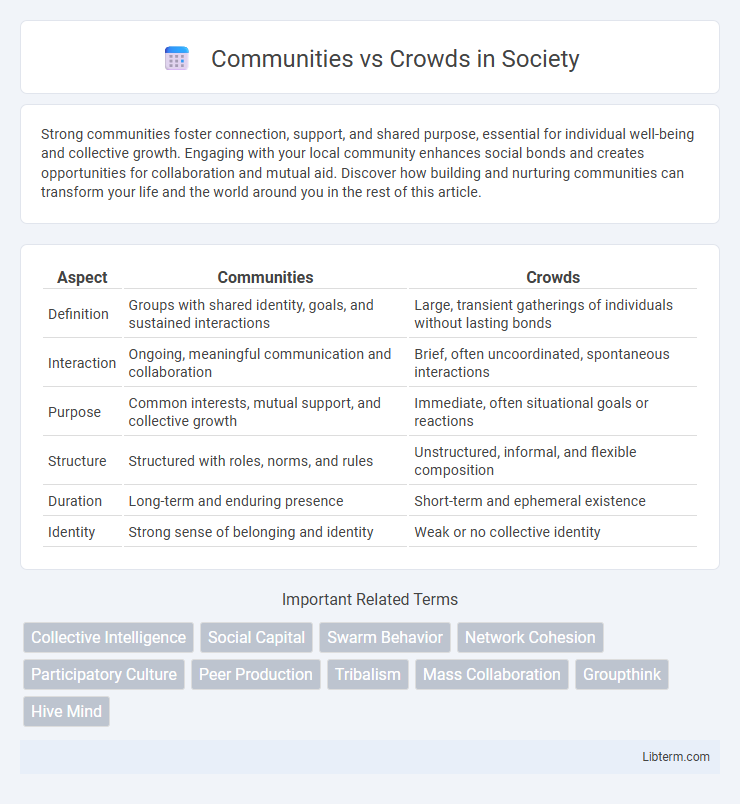Strong communities foster connection, support, and shared purpose, essential for individual well-being and collective growth. Engaging with your local community enhances social bonds and creates opportunities for collaboration and mutual aid. Discover how building and nurturing communities can transform your life and the world around you in the rest of this article.
Table of Comparison
| Aspect | Communities | Crowds |
|---|---|---|
| Definition | Groups with shared identity, goals, and sustained interactions | Large, transient gatherings of individuals without lasting bonds |
| Interaction | Ongoing, meaningful communication and collaboration | Brief, often uncoordinated, spontaneous interactions |
| Purpose | Common interests, mutual support, and collective growth | Immediate, often situational goals or reactions |
| Structure | Structured with roles, norms, and rules | Unstructured, informal, and flexible composition |
| Duration | Long-term and enduring presence | Short-term and ephemeral existence |
| Identity | Strong sense of belonging and identity | Weak or no collective identity |
Understanding the Difference: Communities vs Crowds
Communities consist of interconnected individuals who share common interests, goals, or values, fostering collaboration and long-term relationships. Crowds are large, often impersonal groups of people gathered temporarily, usually driven by immediate, shared stimuli or events without sustained interaction. Understanding the difference between communities and crowds is crucial for leveraging social dynamics in marketing, organizational behavior, and digital engagement strategies.
Defining Communities: Key Traits and Functions
Communities are defined by shared goals, strong interpersonal relationships, and a sense of belonging among members who actively participate and collaborate. Key traits include sustained engagement, mutual support, and collective identity that foster trust and cooperation. Functions of communities often revolve around knowledge sharing, problem-solving, and emotional support, differentiating them from crowds, which are typically large, unstructured groups with limited interaction.
What Makes a Crowd? Characteristics and Dynamics
A crowd consists of a large group of individuals who share a common focus or activity but lack structured relationships or long-term commitment, characterized by spontaneous, temporary gatherings. Crowds display rapid emotional contagion and collective behavior influenced by shared stimuli, often resulting in unpredictable dynamics and heightened suggestibility. Unlike communities, crowds possess low organizational structure, with participants exhibiting anonymity and minimal interaction beyond immediate shared experiences.
Shared Purpose: Community Engagement vs Crowd Participation
Communities center on shared purpose, fostering deep engagement through common goals, values, and sustained interactions that build trust and collaboration among members. Crowds engage primarily through participation driven by diverse, often temporary interests, leading to aggregated input without ongoing relational commitments. This distinction highlights communities as hubs of meaningful connection, while crowds function as pools of distributed, task-specific contributions.
Trust and Relationships: Foundations of Communities
Communities thrive on trust and strong relationships, which form the foundation for meaningful interactions and collaboration among members. Trust in communities develops through consistent engagement, shared values, and mutual support, creating a sense of belonging and accountability. In contrast, crowds often lack these deep connections, resulting in transient interactions without established trust or long-term relationships.
The Power of Collective Action: Crowd Mobilization
Crowd mobilization harnesses the power of collective action by rapidly engaging large groups around a shared goal or event, often leveraging digital platforms to coordinate and amplify efforts. Unlike communities, which build long-term relationships and sustained interaction, crowds excel in mobilizing diverse and dispersed individuals for immediate impact, such as protests, fundraisers, or viral campaigns. The scalability and speed of crowd mobilization highlight its effectiveness in driving social change and raising awareness on a global scale.
Communication Patterns: Community Dialogue vs Crowd Noise
In communities, communication patterns are characterized by structured, reciprocal dialogue fostering deep connections and shared understanding among members, often leading to collaborative problem-solving. In contrast, crowds exhibit fragmented, high-volume noise with rapid, diverse interactions lacking coherence, which can dilute meaningful exchanges and hinder consensus-building. This distinct difference in communication dynamics underscores how communities sustain trust and coordinated action, whereas crowds rely on the sheer volume of inputs without guaranteed quality or cohesion.
Decision-Making Processes in Communities and Crowds
Communities rely on structured decision-making processes driven by shared values, long-term relationships, and collective expertise, leading to consensus and collaborative problem-solving. Crowds utilize decentralized and often rapid decision-making through aggregation mechanisms like voting, crowdsourcing, or prediction markets, harnessing diverse and independent inputs to reach solutions. The quality of decisions in communities benefits from trust and sustained interaction, whereas crowds excel in scalability and variety of perspectives, influencing efficiency and accuracy differently.
Longevity and Impact: Building Sustainable Communities
Sustainable communities foster long-term engagement through shared goals, trust, and active participation, which strengthens social cohesion and collective impact. Unlike crowds, which are often transient and goal-specific, communities emphasize ongoing relationships and knowledge exchange, ensuring resilience and adaptability over time. This longevity enables communities to influence cultural, economic, and social systems more profoundly, creating lasting value beyond immediate outcomes.
Navigating Challenges: When Crowds Disrupt Communities
Crowds often introduce noise and conflicting opinions that disrupt the cohesion essential for thriving communities. Effective moderation and clear communication guidelines are crucial in preserving community values while managing the dynamic influx of crowd interactions. Leveraging technology such as sentiment analysis and community management tools can help identify and mitigate disruptive behaviors early, maintaining a harmonious environment.
Communities Infographic

 libterm.com
libterm.com